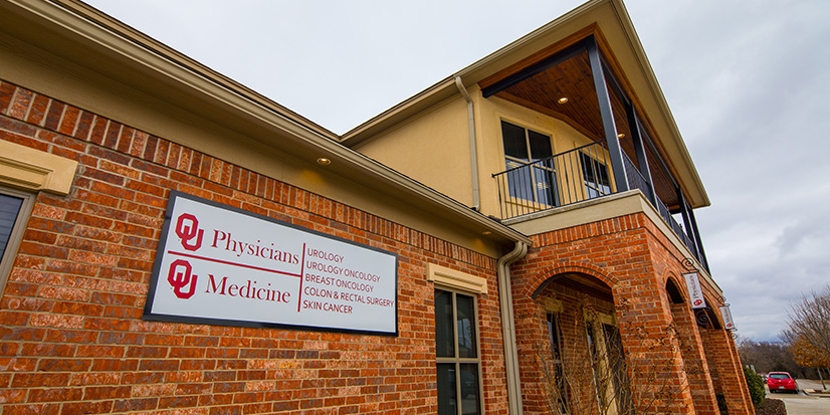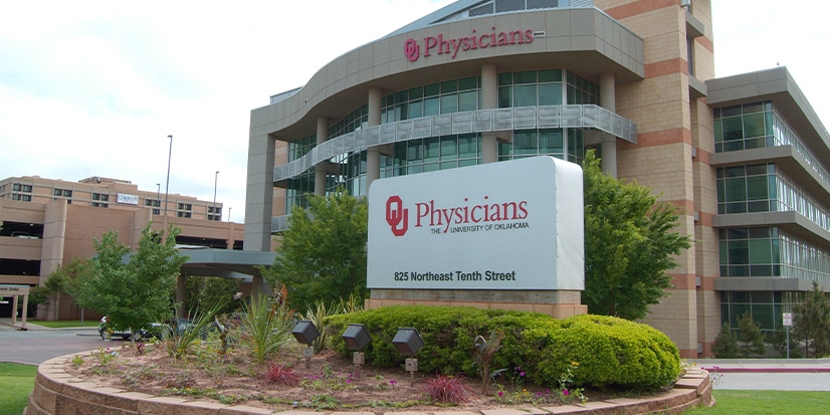Learn More
Request an appointment or ask your doctor for a referral to
OU Health imaging and radiology specialists.
The effectiveness of your medical care depends on an accurate diagnosis and proper treatment. That’s why you want to select a comprehensive healthcare center such as OU Health that combines the latest technology for imaging and radiology with the experienced healthcare professionals, doctors and care team who accurately interpret test outcomes and recommend treatments.
No matter where you live in Oklahoma or throughout the region, you can stay close to home while you take advantage of innovative diagnostic imaging and radiology services at OU Health in Oklahoma City, Edmond and Tulsa.
Learn More
Request an appointment or ask your doctor for a referral to
OU Health imaging and radiology specialists.
Through ongoing advancements in medical imaging technology, many tools, such as X-ray, fluoroscopy or ultrasound, that once were part of basic evaluation, now combine with more powerful, precise, flexible, comfortable and easy-to-use approaches that significantly improve diagnosis.
With the pinpoint accuracy of high-resolution images and fast test results delivered by the latest digital imaging and treatment technology otherwise available at only a few places in the nation or around the world, your OU Health doctors and care team can better identify areas of concern to quickly recommend and begin treatment.
By enabling radiology specialists to see and evaluate images of the body as it moves and functions, advanced radiologic tools at OU Health also become part of less invasive, image-guided treatment and surgical procedures that help reduce harm to surrounding healthy tissue, reduce pain during and after a procedure, reduce or eliminate hospital stays, and contribute to quicker healing and faster recovery than traditional options.
For everything from broken bones and routine screenings to treatment for many types of cancer, brain tumor, heart disease, traumatic injury and other health conditions, your OU Health doctors may incorporate the results of imaging tests from our many innovative tools such as:
As digital imaging continues to advance, OU Health’s expert radiologists look for new ways to expand diagnostic and treatment options with emerging technologies for routine services and challenging health situations that affect soft tissues and internal organs.
The medical specialty of interventional radiology uses this precise imaging to guide small tools through blood vessels and around organs while performing minimally invasive procedures that combine complex treatment planning software with moving and still high-resolution images. Able to reach deep into the body through tiny incisions, if needed, these procedures reduce risk and pain and help speed your recovery.
Explore interventional radiology services at OU Health.
Typically used for cancer treatment, radiation therapy involves administering prescribed doses of radiation, either externally or internally, to a specific site in the body. As you and your OU Health care team review your specific situation and decision factors, including the size, type and location of the lesion, your options for tools and treatment may include:
At OU Health’s Diagnostic Imaging Center, your imaging procedures take place in a comfortable, private area with the support of knowledgeable, compassionate specialists and care team members who accompany you throughout the process. To ensure you receive prompt follow-up, accurate diagnosis and timely treatment, your physician uses our Picture Archiving & Communication System (PACS) to review images securely for evaluation and for precision guidance during surgical procedures.
A bone density scan, or dual-energy X-ray absorptiometry (DEXA), uses very small doses of ionizing radiation to measure your bone mass. From these images, your OU Health doctor works with radiologic technicians to diagnose bone conditions such as osteoporosis and bone cancer. With regular bone density scans, your doctor can visually track your bone condition, recommend early treatments for osteoporosis or other health issues and can make referrals to OU Health orthopedic physicians if needed.
Cardiac catheterization, a minimally invasive procedure, uses a long, thin tube called a catheter to inject dye into an artery in your arm or a vein in your groin. Catheterization visualizes blood flow to your heart during an X-ray or ultrasound imaging test and delivers medicine or other treatment for your specific condition. At OU Health, your doctor may use cardiac catheterization to diagnose conditions that, if left untreated, could lead to heart attack, stroke or other health problems.
A computed tomography (CT) scan takes a series of X-ray images of your body at different angles to create a cross-section of your bones, blood vessels and soft tissues. CT scans provide more detailed images than X-rays so doctors can easily diagnose diseases and plan appropriate treatments. Your OU Health physician uses CT to find internal damage from an injury, pinpoint tumors or blood clots, or monitor diseases and treatments.
Through a low-dose CT scan while you breathe in and out, the Veran SPiN Navigation System provides a 3D map of your lungs. Available in Oklahoma only at OU Health, this advanced imaging procedure offers your doctor a detailed view of suspicious lung nodules, which allows faster biopsy and diagnosis to detect cancer in its early stages.
An echocardiogram uses a small probe that emits high-frequency sound waves. When placed on your chest or abdomen, the probe helps visualize your heart’s structure in 2D or 3D detail. Your OU Health physician examines your heart as it pumps to develop an accurate diagnosis for your specific condition.
During an electrocardiogram, a technician tapes small electrode patches to your chest, arms and legs to measure the electrical activity of your heart. Your doctor can see the speed of your heartbeat, the precise rhythm of your heart and the length of time electrical impulses take to move through your heart. Echocardiograms help your OU Health physician evaluate chest pains or irregular heartbeats, diagnose the overall health of your heart or measure changes that result from treatment.
Fluoroscopy uses X-ray technology to capture a continuous image scan of a specific part of the body as it functions. Detailed images help doctors examine moving body parts, track the progress of instruments during a procedure, or follow the movement of X-ray dyes. Your OU Health physician uses fluoroscopy to better diagnose movement-related conditions in different parts of the body and to assist when inserting devices for procedures or treatments.
Magnetic resonance imaging (MRI) uses powerful magnets and radio waves instead of X-rays to create detailed reconstructed images of your organs and other body structures. Doctors use MRI scans to diagnose internal health conditions and spot tumors. For concerns about radiation exposure, MRI provides your OU Health physician with an effective alternative for painless diagnosis of vulnerable areas such as your heart, brain or spinal cord. When you get care through OU Health’s Stephenson Cancer Center, you and your doctors gain access to 3T (Tesla) MRI, the advanced technology with a stronger magnet that creates more detailed and higher-resolution images of organs and tissues than other types of MRI, ensuring exceptional diagnostic accuracy.
Mammography, a form of low-energy X-ray technology, provides detailed images that allow radiology specialists to examine breast tissue for screening and early detection of breast cancer. As a partner in Oklahoma’s Breast Health Network, OU Health offers extensive women’s health services, including mammography and breast imaging, as well as specialized breast health care.
Nuclear medicine, a specialized area of radiology, uses very small amounts of radioactive substances called radiotracers to look at organs and their functions. During a nuclear medicine scan, a radiologist injects radioactive material or asks you to inhale or swallow it. As the substance gets absorbed by body tissue, radiation detectors allow your doctor to study soft tissues that don’t visualize well in X-rays without using dye. Your OU Health physicians use nuclear scans to view functional issues in organs or bones and develop an accurate diagnosis for your specific health condition. Nuclear medicine also may serve as a treatment option for thyroid disease, various cancers and many other health conditions.
Two types of nuclear medicine imaging are positron emission tomography (PET) and single photon emission computed tomography (SPECT) scans. PET scans use a radioactive sugar that cancer cells absorb in greater amounts than do normal cells. SPECT scans use radioactive substances with antibodies that stick to tumor cells. With a PET scan or SPECT scan, your OU Health physician often can identify cancers and a variety of diseases earlier than when using other imaging tests.
An ultrasound scan uses focused sound waves to make detailed pictures of your organs and body structures. Typically used to help confirm and track pregnancy, ultrasound scans also allow doctors to diagnose a wide range of health conditions, especially those involving soft tissues inside the body, including the heart and blood vessels. Ultrasound scans also assist doctors during medical procedures and when treating certain types of injury. Mostly painless and safer than X-ray, ultrasound also helps your OU Health physician capture images of tissues not possible with X-ray.
The specialized endobronchial ultrasound (EBUS) system assists doctors in procedures to look inside your lungs or take tissue samples in real time. By examining detailed images of your lungs, airways, blood vessels and lymph nodes during the procedure, your doctor can better navigate through this non-surgical option for lung biopsy.
During an X-ray, radioactive electromagnetic waves flow through the scanned portion of your body to produce an image on film. In an X-ray image, body tissue shows up as white, black or gray. The distinctions allow your doctor to better isolate different types of information for accurate diagnosis. Your OU Health physician uses X-ray imaging to diagnose disease or injury, monitor therapy or treatment, or assist in procedures.
You and your doctor can rely on the precision diagnostic results you receive from your expert OU Health imaging and radiology team. You benefit from advanced testing procedures performed by skilled technicians and radiologists trained in the latest evidenced-based diagnostic techniques and using nationally recognized best practices for your safety.











Cervical cancer is a significant health concern for women, yet many myths and misconceptions surround it. These myths can lead to confusion and ...
When it comes to breast cancer, timing is everything. Just ask OU Health breast radiologist Dr. Lori Fredrick, M.D., who has dedicated her career to ...